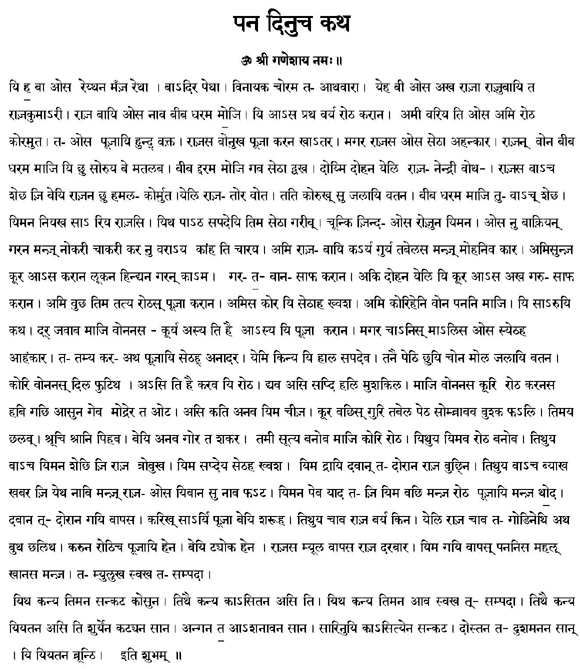
|
| PUNN DIYUN पन्न द्युंन (A Kashmiri Tradition) 
|
|
Punn
Diyun is a Vaishnava ritual related to the invocation of Vishnu as
Bhagawan Satya Narayana, in Kashmir during the Shulka Paksha/Bright
fortnight of the month of Bhadarpada--corresponding to the month of August/ September. In Kashmiri Pandit heritage, this occasion is revered as सत्य देव / Satya Dev, by offering पूर्य Puurya and रोठ Roath to the Satya Dev Bhgawan, along with Shri Ganesha. This day is not the specific Tithi, but should be any Shubh Muhurt--auspicious day in this Paksha of Bhadarapada, as is calculated and recorded, in the Kashmiri Panchangs.
About the word पन्न -- Punn: Punn as a Kashmiri word, meaning thread,and Diyun means to offer. It means to offer the "Thread"--a spiritual obligation in the form of Thread ring that is being tied to the Pot, known as Kalasha. it is generally a brass pot of an elliptical shape revered as the symbol of Lord Brahma, and Varuna Devata /water. The Devata finds its abode in the Kalasha. पन्न Punn word also theवैदिक शब्द word in essence, which means to be worthy of admiration, or to admire to regard with surprise and wonder, to praise and acknowledge. It also means to be glad and glorious. This word has its source in the Sutra सूत्र, स्थुर in Kashmiri, which makes a person learn to be humble, meticulous in his working, and very soft towards the deprived, and to recognize the inner self. It does nort speak of renunciation at all, ather to be in association with the social environment. since it is Vaishnivite ritual, therefore the pot is adorned with flowers of different shades and colors. The Sutra, which is स्थुर ------ An old oral tradition is described here under: The Sutra or कपास/कपस is grown in the fields. Later, it is to be spin on the spinning wheel, after taking the कपसि ट्वट -- seed out of the raw cotton. The spinning wheel is known as यंदुर in Kashmiri. A girl child is supposed to spin the cotton,to turn it into yarn thread, and that thread is offered to the Satya Deva, who is said to have its presence in that Puja, at that particular muhurt/moment. The Sindoor, flowers, नार्य वन and रोठ is offered according to the traditioanal puja with the Naivedya Mantra, known as the प्रेपुन्य . Preparation of रोठ Roath Roath is prepared with wheat flour kneeded with water and milk.and deep fried in ghee. Some would bake the Roath, though kneeded with ghee. It is known as the सवा सेर रोठ। The green cardamom is mixed during kneeding. After frying or baking, Khaskhas-- खश्खाश is applied for decoration purposes as well. Some would make the circular designs with the small circular cup stand. To establish the sanctity of the Punn diyun, the Puja room is washed, all the necessary utensils needed for making a Roath is washed with हुरि म्ये.च --- yellow soil, It is mostly the eldest lady of the family, who narrates the story of बीब गर्भ माs ज, explaining the essence of Satya Narayan Devata, who is Vishnu himself. She would explain the necessity of observing this ritual,purely to ward off ill omens and to bring peace.progress and prosperity in and around the family. That is why, the Naveed is distributed to the neighbours and relatives, without any distinction. Present day procedure: Since the times have changed,now the Punn is not being spinned any more. Only, Diya Batti has replaced the Punn. but all other modalities are followed. except washing with soil, instead the detergent is used to clean the pots/utensils during puja and for preparation of the Roath, which is really very healthy step. The offshoots of green grass, known as द्रमुन is offered to the Devata, with all devotion. After the Puja is over, the Naveed is partaken with all devotion and dedication, even in the KP diaspora. The eldest one of the family observes a fast, but is not obligatory. This day is dedicated to Beeb Ghar Maij, deriving its source of inspiration from the Skanda Purana. About the name ---- बीभ गर्भ माs / Biibh Garbha Mai'j, the main Deity of the Pann Diyun Katha. बीभ is a Sanskrit word, which means --- to put in higher acclamation, in the Post Vedic scriptures. गर्भ Garbha means the cosmic womb, माsज Mai'j is the Divine Mother. That is why we invoke the Divine Mother in the Brass pot/ Gada, with the offering of दूर्वा Durvaa--द्रमण कानुज। The color of brass is of golden hue, hence the brass pot is recommended in the Puja. दूर्वा Durvaa-- द्रमण कानुज stands for the शाकम्बरी देवी / Shakambari Devi. Majority of the Kashmiri Pandits do celebrate the पन्न दियुन, but some families instead perform, Anant Chaturdashi, observing the same ritual of making the Roath. Some address पन्न देवी, as the Bhhib Garaz Mai'j, which does not seem to be correct, as the deity invoked in the pot can never be selfish, as the word ग़रज़ / Garaz stands for. Acknowledgement:---I am thankful to Mrs Chandramukhi Ganju for putting the Roath Katha, published ealier in Shehjar, which is given below |

|

|
|
K a s h m i r i R e c i p e
ChandraMukhi Ganju |
Wednesday, August 31, 2016
PUNN DIYUN
Subscribe to:
Post Comments (Atom)

No comments:
Post a Comment